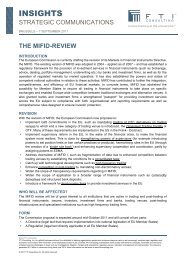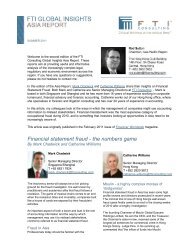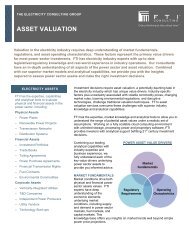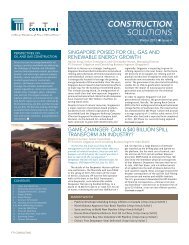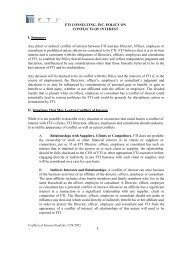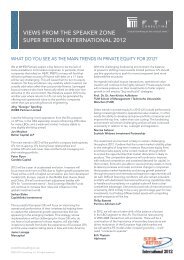Read White Paper - FTI Consulting
Read White Paper - FTI Consulting
Read White Paper - FTI Consulting
Create successful ePaper yourself
Turn your PDF publications into a flip-book with our unique Google optimized e-Paper software.
A tipping point is ignited when the network good hits a critical mass of users and it moves from having niche<br />
utility to mass utility. Because the value of the network increases with its size, a positive feedback loop ensues<br />
-- more people join, it becomes more useful, and even more people join. This leads us to our second<br />
principle:<br />
Principle 2: Being first to market is an even bigger advantage for network goods.<br />
The original service that starts up in a market initially has the bigger size, and Principle 1 says this is where<br />
new members will gravitate. Since the service gets more valuable with size, it follows that the first network will<br />
usually grow faster and reaches a tipping point sooner than later arrivals.<br />
This disproportionate advantage also shows up in the<br />
mathematics. Say AIM initially had 50,000 members versus<br />
MSN’s 10,000. If they each add just one new member,<br />
then AIM will gain 100,000 new connections while MSN<br />
only gains 20,000 2 . The chart at right shows the growth in<br />
connections as both add from one to ten new members.<br />
Of course, consumers don’t do this math, they simply join<br />
the one that is more likely to connect them to the most<br />
people.<br />
We are compelled to warn that being first to market isn’t a guarantee of success or popularity even for network<br />
goods. The features of the service have to be the right ones. (For an excellent elaboration on this subject, see<br />
the book Fast Second by Constantinos Markides and Paul Geroski 3 .)<br />
Network goods and zero-sum games<br />
Networks are often incompatible, meaning that members of one can’t interact with members of another. When<br />
networks are incompatible, the race for consumers is often a zero-sum game, meaning that a gain of a particular<br />
member by one service is a loss to the other. In such cases, when a tipping point is reached, one service<br />
will enjoy a positive tipping point while the other can suffer a negative one.<br />
This has played itself out in the zero-sum competition between MySpace and Facebook. Both were early social<br />
networking sites for teens. However MySpace became very commercialized after being bought by Rupert<br />
Murdock. This turned off consumers – an example of adopting the wrong feature set. Since teens don’t need<br />
two such services, every gain by Facebook has been a loss for MySpace, and its future looks bleak. This<br />
gives us our third principle:<br />
Principle 3: In a zero-sum competition between network goods, the winner takes all.<br />
Facebook was originally smaller than MySpace and should have lost this competition, except that it initially<br />
found safe harbor with the college and high school crowd who wanted to interact privately with other students<br />
but not with the world at large. As MySpace corrupted its original user promise, Facebook became open to<br />
anyone, not just students. Facebook currently has 700 million members and is heading toward one billion.<br />
MySpace is being sold off at the moment for piece-parts.<br />
2<br />
Metcalf’s Law: An interconnected network with N members enables N2 connections. With one additional member, AIM would enable 50,001 2 – 50,000 2 or<br />
100,000 new connections.<br />
3<br />
Josse Boss Press, Copyright Wiley and Songs, 2005.<br />
<strong>FTI</strong> CONSULTING | ADVANCED AD OPTIMIZATION RAISES REVENUE AND REDUCES COSTS IN TELEVISION AND RADIO 4



